In 1702 Sir John Floyer wrote A History of Cold Bathing, promoting immersion in cold water as a cure for just about any disease then known, from scurvy to cancers. Hot springs had never entirely gone out of fashion – the heat must have been a great benefit for all kinds of aches and pains – but bathing of any kind had fallen victim to the displeasure of the church after the Reformation. Partly this was because of the connection with bathing in ancient holy springs and partly because washing the body, let alone taking all one’s clothes off and engaging in a pleasurable activity, suggested sin.
Some bathing houses and plunge pools survive from the 17th century, so the pleasure of bathing, or the belief in its benefits, had never entirely gone away, but it was the 18th century that saw the explosion of the cold bathing craze.
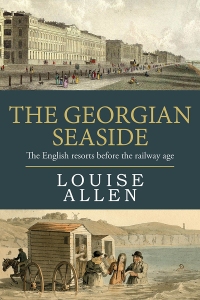 As I found when I was researching for my book The Georgian Seaside: The English Resorts Before the Railway Age, sea bathing did not really take off until the mid-18th century, but the same aristocrats who visited spas began to build bathing houses and plunge pools on their own estates decades earlier.
As I found when I was researching for my book The Georgian Seaside: The English Resorts Before the Railway Age, sea bathing did not really take off until the mid-18th century, but the same aristocrats who visited spas began to build bathing houses and plunge pools on their own estates decades earlier.
The country was stable under the Hanoverians, there was money to indulge in improvements in their grounds and, as well as the health benefits, an architecturally interesting bathing house made an attractive ‘eye-catcher’ in a landscaped park.
I was lucky enough to stay in one of these delightful buildings at the beginning of the month – The Bath House 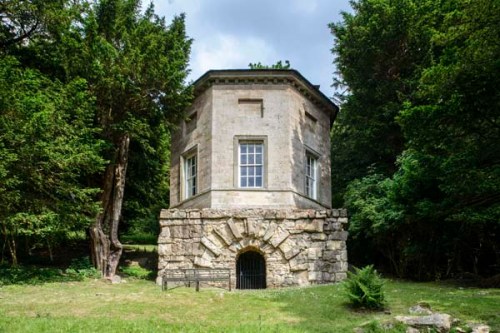 at Walton in Warwickshire, now a Landmark Trust property.
at Walton in Warwickshire, now a Landmark Trust property.
Sir Charles Mordaunt of Walton Hall ordered the bathing house which was completed in 1755. It sits on a hillside in woodland with a glorious view in front and the romantic gloom of the trees behind. The spring-fed plunge bath is approximately 3.5 metres square and deep enough to come up to my shoulders. The chamber is deliberately rustic to appear as though it is a natural cave with a rugged ceiling, vast blocks of stone and a precipitous stair to the room above. Apparently Sir Charles was not averse to people assuming it was of Roman origin – the Fosse Way runs close by.
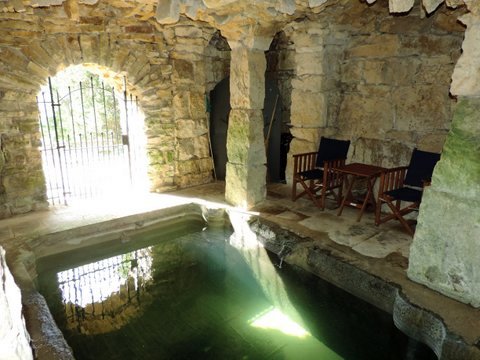
One of the diseases supposedly cured by cold water bathing was gout and as a sufferer, Sir Charles may have hoped this would help. But he was also undoubtedly influenced by fashion and an element of competition with the many wonderful houses and parks in the area, such as Compton
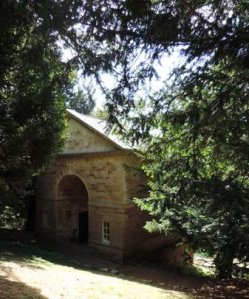
 Verney.
Verney.
The water from deep in the hill, was absolutely icy, the sort of cold that makes your bones ache. But it is also perfectly clear and the flow is strong enough to keep the pool constantly refreshed. The wildlife appreciate it too – there are bats in the ceiling, the Landmark Trust thoughtfully provides a net for frog-removal, and the fallow deer, like these two twin fawns, come to the outfall on the lawn below to drink.
The approach to the Bath House is from the back, through the woods, so there is an element of surprise as you walk in to the incredible drawing room above the bathing chamber.
In contrast to the rough-hewn basement the drawing room is an elegant jewel box with a high ceiling, wide widows and fabulous decoration. Great swags of seashells, each almost 3 metres across, decorate the walls and the ceiling has a mass of thousands of plaster ‘icicles’.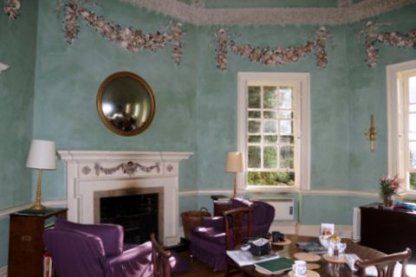
Sir Charles was very fortunate to have the advice and practical help of Mrs Mary Delaney, famous for her exquisite flower pictures created in cut paper. She was also an expert in shell-work, then very fashionable for grottos, summer houses and follies and she sourced shells for the Bath House from the West Indies, Naples, Ireland and the Channel Islands. The swags were mounted in boards by Mrs Delaney herself helped by her sister and Sir Charles’s two daughters.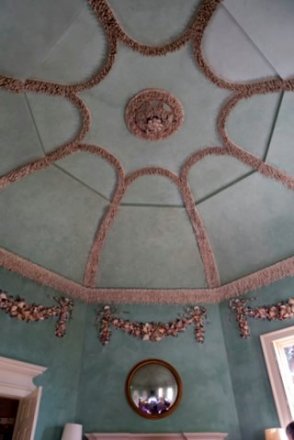
When the building was taken over by the Landmark Trust it had been severely damaged by vandals and the swags and icicles had to be re-made. The interior is now restored to its former Georgian glory and staying there is a wonderful experience. We slept with the shutters open so that when we woke we could look up into the gorgeous ceiling before tip-toeing to the window to see if the deer and their fawns were on the grass below. I have to confess that one dip in the pool was enough and it was fortunate that there were no neighbours – the screams of anguish were so loud!
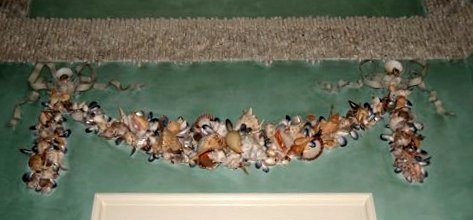


Oh, it looks wonderful! That plunge pool must have been SO tempting in this weather. Was it your Wimpole Hall book that featured an indoor pool?
Yes, Wimpole Hall has an indoor heated bath. This one was bone-achingly cold though!
I suppose it was one way to cool down an over-amorous suitor…